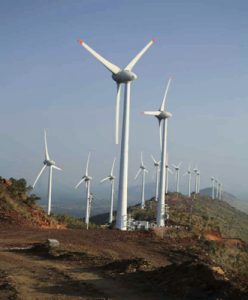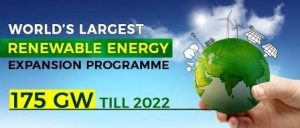The Roadmap of Renewable Energy Development in India
Sustainability in the present and its facilitation for the future generation will always be the prime concern for change-makers. The face of the bumpy road leading to our renewable energy future is gradually transforming into a smooth surface.

India announced its ambitious plan to set up 500 gigawatts (GW) of renewable capacity by 2030 at the 17th meeting of the International Renewable Energy Agency (IRENA) council in Abu Dhabi to decrease global emission. The government is already running its project of achieving 175 GW of renewable capacity by 2022, which includes 100GW from solar, 60GW from wind, 10 GW from Biopower and 5 GW from small Hydropower. Currently, India has installed around 80 GW of renewable energy. The National Democratic Alliance (NDA) government in its second term has a clear aim of providing reliable, sustainable and affordable electricity to the masses through green energy sources. This project is meant to decrease carbon emissions as per the Paris Agreement on Climate Change.
India is the third-largest energy consumer in the world but per-capita electricity consumption is around a third of the world average. To reduce global emissions, the government aims to generate electricity using renewable sources. It is important to use renewable sources to meet the growing demand for electricity which is due to high economic and population growth, along with increased urbanization and industrialization.
The Ministry of New and Renewable Energy (MNRE) in India has been facilitating the implementation of broad-spectrum programmes, including harnessing renewable power, renewable energy for rural and urban areas. Besides, it supports research, design and development of new renewable energy technologies, product and services. Renewable energy is the energy produced from the sources that do not deplete and it can be replenished within human life. The most common examples are solar, wind, geothermal, biomass and hydropower.
India is at the 5th position for overall installed renewable energy capacity, globally.
In 2015, NITI Aayog released India’s Renewable Electricity Roadmap 2030 at RE-Invest to analyse the opportunities and barriers to the rapid deployment of renewable power in India. Later, it involved working with the state governments to facilitate the generation and integration of renewable sources into their mixes. In April 2018, NITI Aayog and International Energy Agency (IEA) with the support of the Asian Development Bank (ADB) conducted 4 workshops in India. These workshops aimed to discuss and analyse the trends and challenges in India’s electricity sector to achieve 175 GW of power capacity from renewable sources.
A total of 100 billion units of power have been generated in the country during the year 2017–18 from all renewable energy sources. The capacityfor cumulative renewable energy installed has increased from 35.51 GW as on 31 March 2014 to 69.98 GW as on 31 March 2018.According to the Union MNRE, renewable capacity has reached 73 GW, accounting for over 20 per cent of the country’s total. Solar has performed particularly well: in 2017–18 alone, around 10 GW of solar was installed equalling the entire installed base.Generation of renewable energy has also increased sharply. Its share in total electricity supply had stalled at around 5.5 per cent during 2011–16. But in 2017–18, its share jumped to 7.8 per cent
The Indian government has introduced some amendments in tariff policy to promote renewable energy, for example, Mandated Renewable Purchase Obligation (RPO) and Renewable Generation Obligation (RGO), permitting Foreign Direct Investment (FDI) up to 100 percent under the automatic route, waived interstate transmission charges for solar and wind energy. The government has also implemented the Green Energy Corridor project to facilitate grid integration of large-scale renewable energy capacity addition. In spite of these amendments in tariff policy, the offtake of power generated through renewable energy is still a challenge due to its price competitiveness with conventional sources of power.
Also Read : Necessary To Build A Political Mandate For Decentralised Renewable Energy/
There are few barriers in integrating renewable power system into the Indian Grid, as renewable energy sources are non-dispatchable, which means that they can generate electricity but cannot be turned on or off to meet the electricity demand, also such sources are not available continuously due to unpredictable weather conditions. Thus, the power system would require a dispatchable plant when the renewable generation of energy is not available. The changes to the current power system can be brought about by a phased manner to prevent the system from any sudden changes.

The main aim to opt for renewable energy sources is to tackle climate change which is a big challenge for any nation. Dependency on fossil fuels, especially coal, would not help to mitigate climate change. The coal-fired plant generates 72 per cent of electricity in India. According to BP Energy Outlook 2019, coal’s share in India’s primary energy consumption will decline from 56 per cent in 2017 to 48 per cent in 2040. This is still high because it is nearly half of the total energy used and way ahead of any other sources of energy. According to the report, renewable energy consumption in India will surge from ~20 Million Tonnes of Oil Equivalent (Mtoe) today to ~300 Mtoe by 2040—concentrated mainly in the power sector and driven largely by growth in solar capacity. Yet despite this growth in renewables, coal continues to dominate India’s power generation mix, accounting for 80 per cent of the output by 2040.
In 2018, Renewable energy projects faced regular problems like lack of planning, poor tender design and arbitrary tariff ceilings, which led to the cancellation of multiple projects.
Shakti Sustainable Energy Foundation report states that in 2018, installation dropped to almost 6.6 GW in the month between January and September. Tariff went up as the Government of India introduced a safeguard duty on imported Photovoltaic (PV) modules. The report emphasized on abrupt policy changes, as in these abrupt changes would not be beneficial for an emerging sector like renewable energy. Introduction of safeguard duty on imported PV modules has resulted in uncertainty about project costs, an increase in tariffs and consequently a drop-in installation. India’s solar capacity has been built on a 90 per cent share of imported PV modules because their costs are up to 30 per cent lower.
According to the RE Outlook Report 2019, there would be an addition of 15,860 MW RE capacity in 2019, which is a 50 per cent increase from 2018. This report emphasises that capacity addition is expected to be low in the first half of the year due to elections, but is expected to accelerate in the second half.
According to a recent analysis, the Government of India launched Saubhagya Scheme in 2017. It was aimed at electrifying all excluded Indian households by March 2019. ‘Power for All’ scheme was launched, which includes generation and distribution of electricity, energy efficiency and improving the financial health of distribution companies. A prerequisite to ‘Power for All’ is connecting all households to the grid. These two schemes cover both rural and urban areas to provide 24×7 power, and has seen tremendous success with household connections reaching 100 per cent in all the states with exception to Chhattisgarh, where the current electrification rate is 99.65 per cent.
Also Read : Change Is In The Air
These schemes put pressure on issuing more tenders, the Saubhagya scheme puts additional force on some Distribution Companies (DISCOMs) to fast track renewable energy tenders because the next step of the government is to provide sustainable 24×7 electricity. International Solar Alliance (ISA) signed by India in 2015 works against climate change. Its aim is to develop solar resources in various countries to reduce their reliance on non-renewable energy.
Analysing the roadmap of renewable energy development in India implies that the nation is heading towards the efficient direction to achieve its goal of attaining 175GW of renewable energy by 2022. Few obstacles that often come in the way of these projects are related to affordability, availability of infrastructure, announcement of multiple tenders and intermittent availability of renewable energy due to weather. However, mitigation of these obstacles would help the nation to achieve its goal on time and pursue another goal of achieving 500 GW of renewable energy by 2030. Shakti Sustainable Energy Foundation in its report recommends some way forward: there should be new policies to determine tariffs and schedule power, increase the share of distributed renewable generation, DISCOM models needs to be rethought. As per my observations, policies should ensure that open access consumers pay an equitable amount for network access and back-up supply; in the initial years, there should also be a provision for a cross-subsidy.
